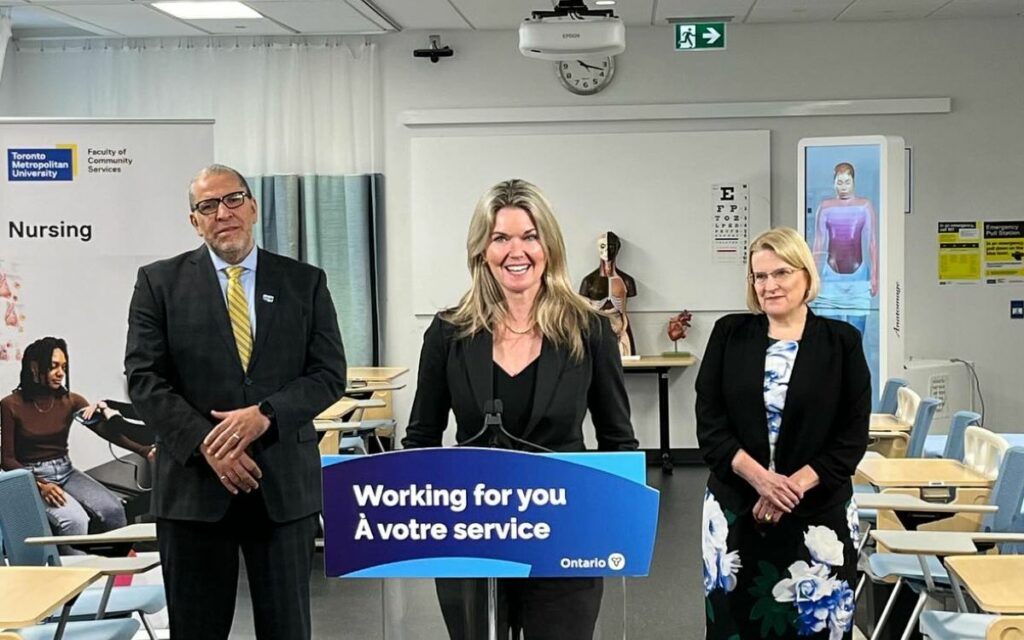
Photo Credit: Facebook/Jill Dunlop
When judging the value of the recently released “Blue Ribbon” panel on the financial sustainability of Ontario’s post-secondary sector, it is helpful to remember why governments so often use such bodies to help make policy decisions.
Critics often accuse governments of passing the buck or ducking their decision-making responsibility when they set up such bodies. But on the contrary, they offer several helpful advantages.
Their reports provide “expert” or “independent” opinions, a helpful defence if a government acts on the advice to resolve a controversial problem. Their conclusions can also act as trial balloons, publicly floating options so that a government can assess the reaction of stakeholders and voters before making a decision.
On both counts, the Blue Ribbon panel should prove a useful tool for Colleges and Universities Minister Jill Dunlop as she and her cabinet colleagues decide how to craft a new, sustainable financial model for the post secondary sector.
As the report points out, the sector has been struggling with various funding freezes dating back to the previous Liberal government. When the Premier Doug Ford government was elected in 2018, it cut tuition fees for students by ten per cent and fees have been frozen ever since. It was a popular political move but it only increased the sector’s financial pressures.
Matters only got more challenging when inflation hit and universities could not enrol more domestic students because the previous government had imposed a funding cap. The acute housing shortage has also placed a limit on the number of international students universities could enrol as they commit to help students find a place to live. The triple whammy resulted in several unintended consequences.
As the Auditor General pointed out last year – eight of the 23 universities were running deficits, with four more expected to do so, one has already filed for bankruptcy protection and others are over extended. The Auditor General and the panel also noted that colleges have become overly dependent on high-risk revenue from international student fees.
Having made a strong case for more funding, the report recommends two major changes – a one-time tuition fee hike of five percent as part of a three-year framework with further increases of two per cent and a ten per cent increase in operating grants, followed by annual increases of two per cent.
The tuition hike, if the government adopts the advice, will no doubt create political flak from students and their families. The report recognizes the challenge and points out that the government has tools to moderate any negative impact through its student assistance programs. And the university sector itself has also pledged to direct ten percent of any additional tuition revenue to more student financial assistance.
Not surprisingly, the media focused on the call for more sector funding and criticized Minister Dunlop for not immediately agreeing. Instead, she said she would not increase funding until she was sure that “colleges and universities are taking the necessary steps to ensure that they are operating as efficiently as possible.”
Little attention was paid to the fact that the panel also agreed that more efficiencies were not only needed, but possible. It estimated that as much as ten per cent in administrative savings could be achieved and listed a number of ways this could be done. It also noted that some institutions were already moving in that direction.
The Ministry of Colleges and Universities has already put forward a new financial accountability framework that would require the reporting of financial heath indicators and third-party credit rating reviews. This builds on an earlier proposal submitted by universities last year that would require action to be taken if indicators flagged a concern.
So it would seem that the Blue Ribbon panel has given the government the ammunition it needs to defend both a tuition hike and more operating funds, should it decide to do so. Plus, the sector appears ready to meet the Minister’s quid pro quo.
With the number of Ontario high school students applying to post-secondary institutions increasing and the economy demanding more and more highly skilled workers in all fields, the sector needs to be able to respond.

Janet Ecker is a former Ontario Finance Minister, Minister of Education, Minister of Community and Social Services and Government House Leader in the governments of Premier Mike Harris and Premier Ernie Eves. After her political career, she served as the founding CEO of the Toronto Financial Services Alliance, a public-private partnership dedicated to building Toronto region into an international financial centre. She currently sits on a number of corporate and non-profit boards, agencies and advisory committees.
Ms. Ecker received the Order of Canada for her public service contributions and was recognized as one of the “Most Influential People in the World’s Financial Centres” by Financial Centres International. She also received a “Canada’s Most Powerful Women: Top 100 Award” from the Women’s Executive Network and the Richard Ivey School of Business, among other awards. She is also one of the founders of Equal Voice, a national, multi-partisan organization working to elect more women.




















